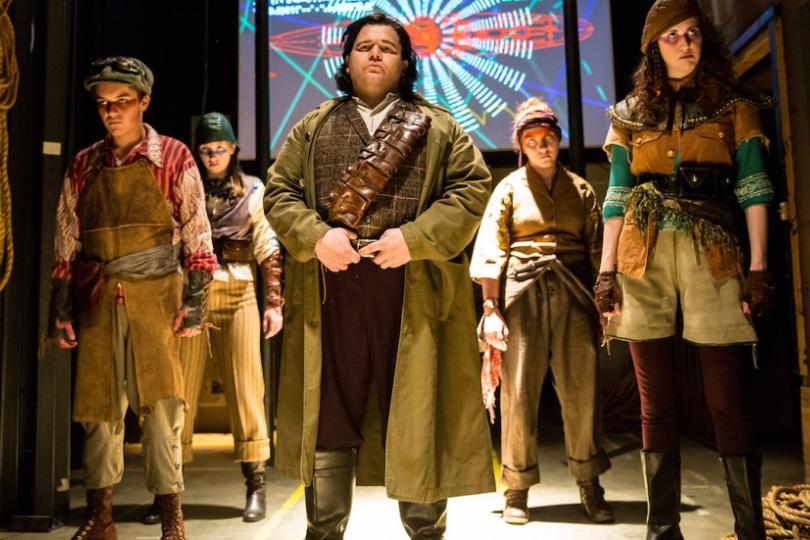Holes under the sea

The Children’s Theatre Company’s new production of 20,000 Leagues Under the Sea is a unique creation, a physically immersive, visually inventive exercise in frenetic storytelling that takes set design and stage direction to places seldom visited by local theater companies. The trouble is, I’m not sure any of that makes it a particularly good play.
Show creators Ryan Underbakke and Nick Ryan have developed less a straight adaptation of Jules Verne’s classic undersea novel than a sequel. Audience members enter a small waiting room and assume the roles of ensigns with ORKA, a quasi-military organization tasked with capturing the Nautilus, the super-submarine commanded by legendary aquatic terrorist Captain Nemo. Expository dialogue informs us that Nemo is suspected of attacking multiple vessels and kidnapping the famous Professor Arronax, the protagonist/audience surrogate of Verne’s original story. From there it’s a fast-paced scurry through dimly lit rooms filled with blinking instrument panels as the audience follows two ORKA representatives on an increasingly complicated and morally ambiguous rescue mission.
Set design of the highest order
Ever since the show was announced, the big buzz around 20,000 Leagues Under the Sea has been that the action takes place not on the Children’s Theatre stage, but in the theater’s rarely seen back rooms and corridors. There’s no question that the staging of this show ranks with the most ambitious in recent memory. Every time one of the actors orders the ensigns to move out, the show lurches into yet another mesmerizing set, jumping from a control room dominated by a massive view screen to a scientist’s tastefully appointed living quarters to a dingy detention cell filled with menacing Nemo acolytes.
The most striking of these settings is a small room that houses the ship’s “living battery.” It’s a creepy, unforgettable tableau that stands as the best realization of the production’s delicate balance of interactive theater, narrative propulsion and inventive imagery. Elsewhere, the show makes excellent use of multimedia design, with video monitors and radio transmissions carrying much of the expository burden. It’s not just design for design’s sake either - in at least one scene, sharp-eyed ensigns can watch a key plot point develop on a peripheral screen while the major action unfolds in front of them.
The show’s press notes explain that it’s partially inspired by video gaming, which makes a lot of sense. It’s structurally very similar to any number of first-person adventure games in which the player explores a landscape, completing missions and interacting with exposition-spouting tertiary characters on the way to a climactic confrontation. Taken as a live-action video game, 20,000 Leagues Under the Sea works quite well. Underbakke’s direction keeps the action moving fast and reveals the story’s mysteries little by little, simultaneously translating two art forms - the video game and the science-fiction novel - into a live production.
Who is the protagonist?
But that isn’t quite enough to make it work as theater. For all of the technical wizardry on display in 20,000 Leagues Under the Sea, there’s a curious hollowness to the experience. The video game structure is partly to blame for that. On our walk back to the car after the show, my son asked me who the main character in the play had been. The best answer I could come up with was that it was us, the “ensigns.” On further reflection, though, that didn’t quite add up.
In a first-person video game, the player truly is the main character, controlling the action and making decisions that figure into the outcome of the narrative. The fundamental difference with 20,000 Leagues is that the audience members are, by necessity, mostly passive participants. Save for one key moment when the ensigns are asked to make a quick, collective decision, we’re mostly just along for the ride. That leaves a hole at the heart of the narrative that the production can’t quite overcome.
We encounter plenty of colorful characters along the way, but with the story moving along at such a rapid clip and the setting changing every few minutes, very few of them have a chance to make much of an impression. (The big exception being Meghan Kriedler’s hard-boiled military commander, a performance brimming with physicality and action-hero bravado.) Despite being a literal part of the action, I never felt truly immersed the way I do sitting in the crowd during a truly engaging traditional play. Instead, I left the theater feeling sort of the way I do after visiting a well-done Halloween haunted house tour.
This leaves me with a bit of a conundrum as a reviewer. I can’t exactly call 20,000 Leagues Under the Sea a good play, or even an especially enjoyable one. At the same time, it is a one-of-a-kind theater-going experience and a remarkable technical achievement. For as much it didn’t work for me, I’m happy to have witnessed it. If that reads like a recommendation to you, you can probably safely take it as such.




